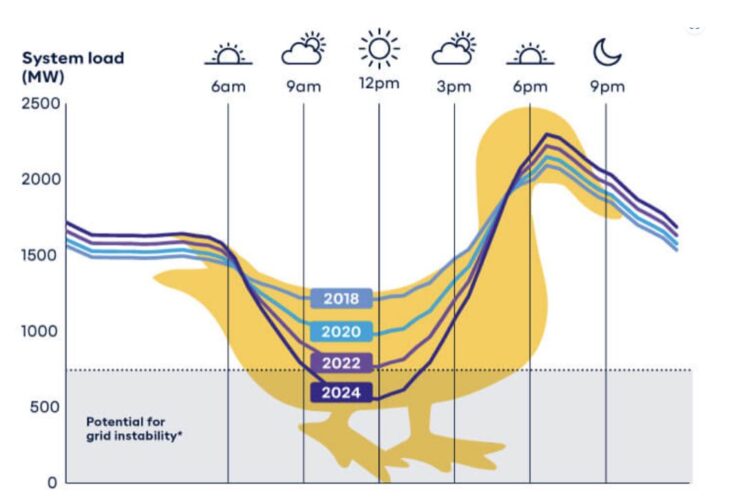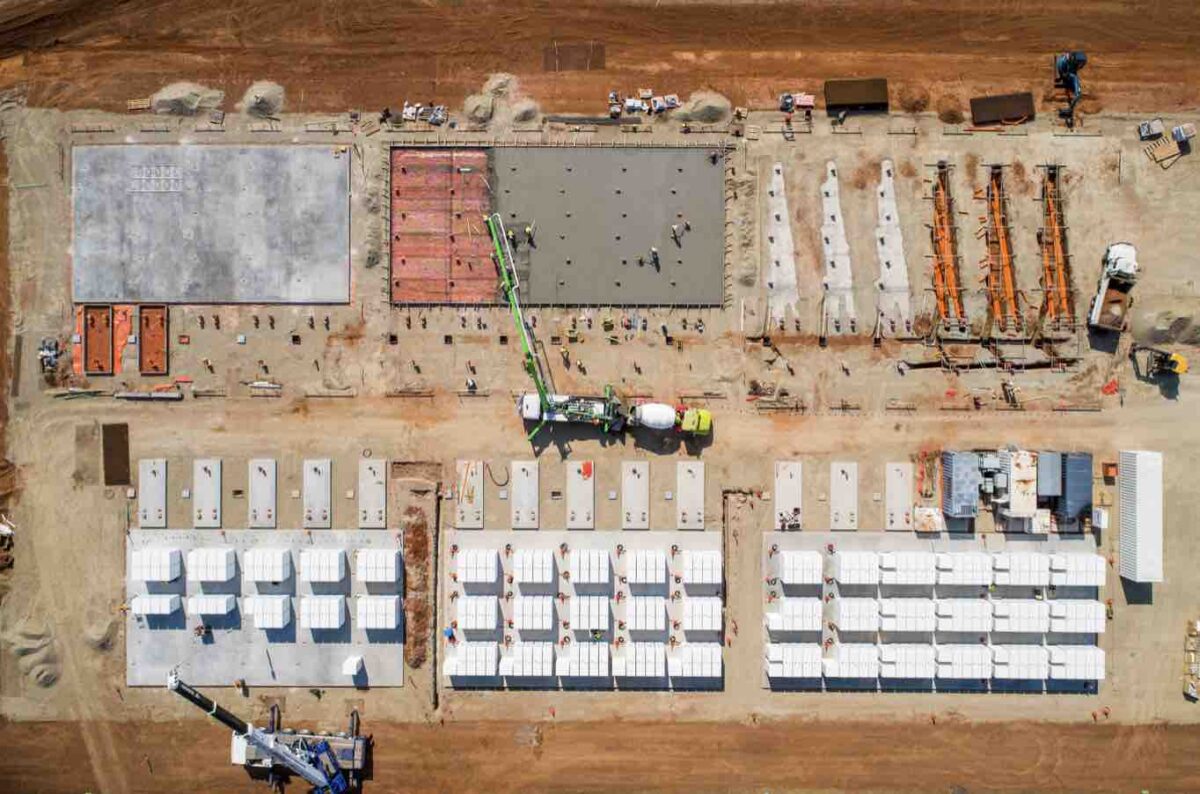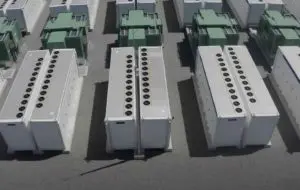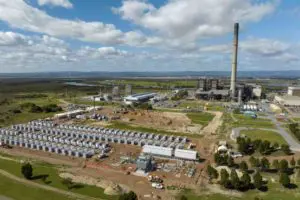French based renewable energy and storage developer Neoen is to build a massive four-hour battery in Western Australia after securing a landmark contract designed to solve the growing solar duck curve problem in the world’s biggest isolated grid.
Neoen is to build a 219MW, four hour (877MWh) battery near the coal town of Collie, the first stage of what could grow to be a 1GW, 4GWh battery as the state dramatically ramps up its renewable plans and closes down coal.
The nature of the contract with the Australian Energy Market Operator – like those negotiated for the original Tesla big battery, aka the Hornsdale Power Reserve, and the Victoria Big Battery – is a first of its kind.
Neoen will be contracted for two years to make 197MW of battery storage capacity available for four hours during the middle of the day (between 10am and 2pm) to charge, and lift minimum demand levels on the grid.
It will be required to provide a similar capacity in the evening peak, between 4.30pm and 8.30pm, in this case to help reduce demand.
Unlike the Hornsdale and Victoria and Big Battery contacts, the payments for this contract have not been revealed.
But Neoen, in a separate announcement – said it would lift its forecast operating earnings in FY 2025 to more than €700 million ($A1.13 billion) from the €600 million ($A954 million) previously advised just a month ago in May.
That is an increase of $160 million a year, and while Neoen is saying that not all that profit lift derives from the battery deal, given the short time frame it suggests it accounts for a large part.
The solar duck
The contract is designed to reduce the so-called “solar duck” curve caused by the rapid uptake and output of rooftop solar, which reduces grid demand to low levels before ramping up quickly in the late afternoon as the sun goes down.
AEMO has described the solar duck, and the fall of minimum demand to levels where it makes the grid difficult to manage (which it nominates as 600MW) as one of the biggest challenges of the shift to renewables.

This solar duck (see graph above) was used in a presentation by the state-owned utility Synergy to explain the need for another huge battery planned for Collie, Synergy’s 2GWh battery that was announced just a few weeks ago. Note the forecasts of falling demand in the middle of the day in 2024.
The two year contract for Neoen will begin in October, 2024, and last for two years. The timing appears designed to cope with the retirement of another of the state’s coal generators, and amid the growing uptake of rooftop solar, and possibly also the time needed for Synergy to build its own facility.
The two huge battery projects in Collie come as the WA government fast-tracks its shift from a fossil fuel based grid to one dominated by wind, solar and storage, recognising that coal and gas are both dirty and expensive, and that there is a huge opportunity in building the energy infrastructure for zero carbon industries.
It recently issued a new demand forecast that modelled the need for more than 50GW of new wind, solar and storage in its grid to meet the demands of green hydrogen and other green industries looking to source zero carbon power.
The state’s more immediate focus, however, is to provide the required firming capacity to allow coal to exit and to support the growing share of rooftop solar in WA, which is the world’s largest isolated grid and has no ability to import or export power.
Neoen’s Western Australia head Nathan Ling said the company identified a need for battery storage several years ago.
“I think this demonstrates that markets are changing as we’re becoming more less reliant on fossil fuel generation and more on renewables,” Ling told RenewEconomy.
Tesla chosen for Megapack batteries
“The services from batteries are also changing, away from the frequency and ancillary services which batteries will continue to provide and this one will do the same, but also providing more of those firming services by being able to firm up renewables and and shift generation to when it’s most needed.”
Neoen says it has been working on the project since 2021, and has already given a notice to proceed to construction company UGL, and to Tesla, which will supply 224 of its Tesla 2XL Megapacks.
The first stage will be sized slightly larger than the AEMO contract, and the facility has planning approval for a total of 1GW / 4GWh of battery storage. It will located next to the Shotts Terminal substation near Collie, on the country of the Wilman people of the Bibbulmun nation.
The Collie battery will be the first four hour battery to be built by Neoen, and its sixth large standalone battery overall in Australia. It also owns several large wind and solar projects.
The Hornsdale Power Reserve (now 150MW/193MWh), and the Victoria Big Battery, which remains the biggest at 300MW/450MWh, are both contracted to provide specific grid support services.
Neoen is also building the 100MW/200MWh Canberra big battery as part of a deal with the ACT government, has started construction on a 200MW/400MWh battery next to the Western Downs solar farm in Queensland and the 200MW/400MWh Blyth battery in South Australia, helping to supply BHP’s massive Olympic Dam mine.
The company also owns the smaller 20MW/34MWh Bulgana battery located next to the wind farm of the same name in Victoria, and the 6MW/1.4MWh battery at the Degrussa mine in W.A.
Neoen’s sixth big battery in Australia
“This is an exciting time for Neoen as it is our first major project in WA, and it also means we now have a big battery in five of the six Australian states,” Louis de Sambucy, the head of Neoen Australia, said in a statement.
“With our growing team in Perth and a strong pipeline of projects we look forward to playing an increasingly significant role in the state’s rapid decarbonisation.”
His boss, Neoen CEO Xavier Barbaro said the battery deal once again proved the company’s ability to rapidly provide solutions to the market.
“We are thrilled to start delivering longer duration battery services,” he said. “Neoen is incredibly proud to be one of the world’s true pioneers in battery storage, with a global portfolio of over 1.3 GW / 2.6 GWh, and to be making a major contribution towards a more sustainable energy future.”
AEMO CEO Daniel Westerman said investments in low-cost renewable energy backed by firming generation, such as batteries and gas, and augmentation of the transmission network, will be needed as the state moves away from coal.
Security and reliability
“Neoen’s Collie Battery, procured through AEMO’s NCESS process, will provide consumers with energy security and reliability during the transition to firmed renewables,” he said.
NCESS stands for Non co-optimised essential system Services. AEMO opened a tender for the contract in December last year and notified the winners in April.
AEMO is so concerned about the minimum demand issue – particularly in spring when it is both sunny and mild – that it has since opened a new tender for 125MW to come into effect from this year, for a 12 month period until the Neoen battery is ready.
The facility will take advantage of the considerable energy infrastructure in the region, and will offer community support through a special purpose fund..
“Renewable energy infrastructure, such as Neoen’s big battery, is a key factor in the attraction of new, innovative and sustainable industries that will cement Collie’s place as an important industrial hub, providing worthwhile employment opportunities for generations to come,” said Collie shire president Sarah Stanley.
See RenewEconomy’s Big Battery Storage Map of Australia
And: Big batteries storm the fossil fuel citadels, and spell the end for coal and gas











